 Last Updated: Dec 18, 2010 |
The Ancestors of א/B: |
 Last Updated: Dec 18, 2010 |
The Ancestors of א/B: |
|
Ancestor MSS: - א/B |
Originally the NT books were written separately, and circulated separately, and only later gathered into collections such as the Four Gospels, or the Letters of Paul, into one manuscript copy.
Rightly then has James Snapp Jr. insisted that the early textual history be analyzed separately, book by book:
"2. The text of the New Testament should be reconstructed in its component-parts: Gospels and Acts and Pauline Epistles and General Epistles and Revelation. Relationships shown by patterns of readings in one part should not be assumed to exist in the others."
Grouping and Organizing the Omissions of Aleph/B
If we take then the Gospel of Mark in hand, and list all the significant omissions by Aleph/B followed by the modern critical GNTs, we make some amazing and enlightening discoveries.
The omissions fall easily into three basic groups, with the missing letter counts being multiples of typical column widths for manuscripts from the late 2nd and early 3rd centuries. In other words, we can reconstruct what some of the ancestors of the common ancestor of Aleph/B looked like, to account for these strong correlations in line-length and column-width.
Since earlier ancestors (late 2nd century) had wider columns, the groups of omissions can be ordered chronologically and traced to the copyist who used such a manuscript as a master-copy.
We expect to find similar results when turning to the other gospels, especially the larger ones, such as Luke. However we cannot extend our findings here until each gospel is checked separately, as many of these errors probably accumulated when the Gospels were circulating either separately or in copies of the Four Gospels, as opposed to whole New Testaments.
| Mark: Masterlist | ||||
|---|---|---|---|---|
| verse | chrs | omissions (20-22 letters per column) | WH | TYPE |
| 1:1 | 11 (7) | υιου του θεου |
Om | (h.t.) |
| 1:14 | 12 | της βασιλειας |
Om | -- |
| 1:42 | 13 | ειποντος αυτου |
Om | (h.t.) |
| 3:5 | 12 | υγιης ως η αλλη |
Om | -- |
| 3:15 | 22 (11) |
θεραπευειν τ |
Om | (h.t.) |
| 6:11 | 74 6x12 5x15 4x18 3x24 |
αμην λεγω υμιν ανε |
Om | (h.a.) |
| 6:33 | 20 |
και συνηλθο |
Om | (h.t.) |
| 6:36 | 10 (+3) | ουκ εχουσιν |
Om | (h.t.) |
| 7:2 | 9 | εμεμψαντο |
Om | (h.a.) |
| 7:8 | 61 6x10 4x15 3x20 |
βαπτισμους ξεστω |
Om | (h.a.) |
| 7:16 | 26 2x13 |
ει τις εχει ωτα α |
Om | (h.a.) |
| 8:9 | 10 | οι φαγοντες |
Om | -- |
| 8:26 | 21 |
μηδε ειπης τ |
Om | (h.a.) |
| 9:29 | 10 | και νηστεια |
Om | (h.a.) |
| 9:38 | 18 | ος ουκ ακολουθει ημιν |
Om | (ed.) |
| 9:44 | 44 4x11 3x15 |
οπου ο σκωληξ αυτ |
Om | -- |
| 9:45-6 | 62 |
εις το πυρ το ασβεστ |
Om | |
| 9:49 | 26 2x13 |
και πασα θυσια α |
Om | (h.t.) |
| 10:7 | 38 2x19 |
και προσκολληθησεται |
Om | (h.t.) |
| 10:21 | 14 | αρας τον σταυρον |
Om | -- |
| 10:24 | 29 2x15 |
τους πεποιθοτας |
Om | -- |
| 11:8 | 23 2x12 |
και εστρωννυο |
Om | (h.t.) |
| 11:10 | 15 | εν ονοματι κυριου |
Om | -- |
| 11:23 | 8 | ο εαν ειπη |
Om | -- |
| 11:26 | 70 4x18 5x14 |
ει δε υμεις ουκ αφ |
Om | (h.t.) |
| 12:23 | 13 | οταν αναστωσιν |
(In) | -- |
| 12:29 | 15 | πασων των εντολων |
Om | -- |
| 12:30 | 15 | αυτη πρωτη εντολη |
Om | -- |
| 12:33 | 17 | και εξ ολης της ψυχης |
Om | (h.a.) |
| 13:11 | 12 | μηδε μελετατε |
Om | (h.t.) |
| 13:14 | 27 2x13 |
το ρηθεν υπο δαν |
Om | (h.t.*) |
| 14:19 | 15 | και αλλος μητι εγω |
Om | (h.t.) |
| 14:27 | 20 2x10 |
εν εμοι εν τη |
Om | (h.a.) |
| 14:68 | 18 | και αλεκτωρ εφωνησεν |
(In) | (h.t.) |
| 14:70 | 20 2x10 |
και η λαλια σ |
(In) | (h.t.) |
| 15:3 | 22 2x11 |
αυτος δε ουδε |
Om | -- |
| 15:28 | 46 3x15 |
και επληρωθη η γραφ |
Om | (h.t.) |
Taking the convenient list of Markan omissions from the last post in hand, one immediately notices that the five largest chunks of text uncannily break into lines with 15 characters per line. This is a strong correlation, and not likely to be a mere coincidence. It is further corroborated by other shorter omissions, also breaking down into lines of 14-15 characters.
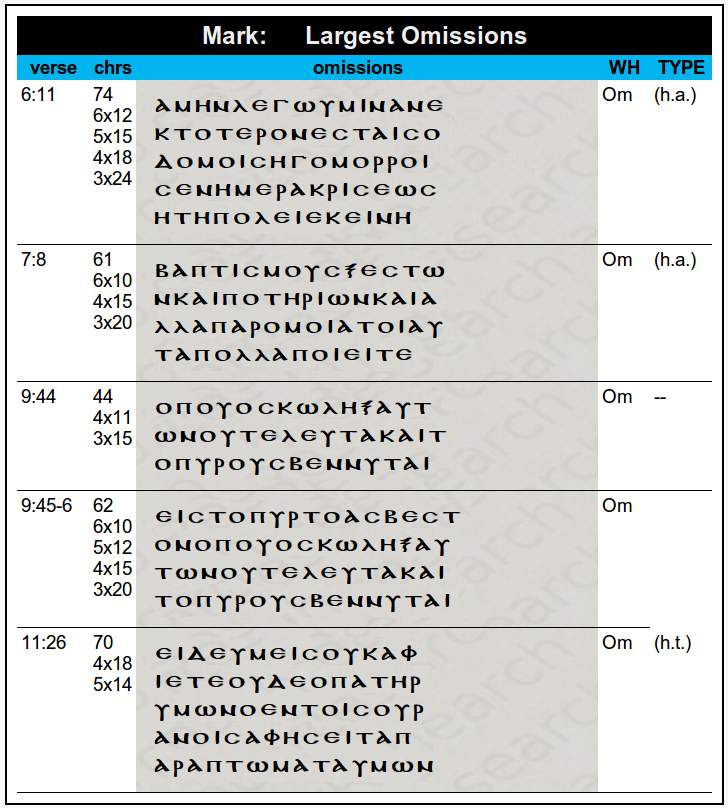
The following group, which we have labeled "Ancestor 1", conveniently groups line-lengths of 20 - 23 together. Although the 2nd half-chart may belong to a different (later) exemplar, the wider format is variable enough that all the omissions could also have been generated from one master-copy.
Relatively few omissions would be from the older layers, especially obvious cases of homoeoteleuton, because some would be caught in subsequent generational copying and proofreading. The omissions without homoeoteleuton features would be most difficult for correctors to find and properly identify. We should not then be surprised that the early candidates would be somewhat fewer in number.
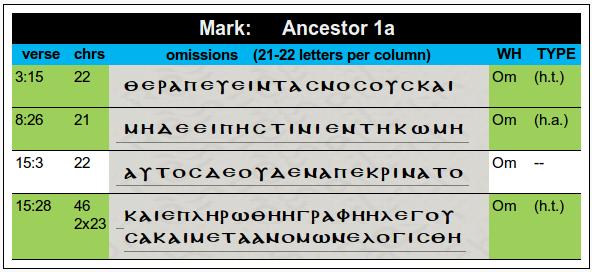
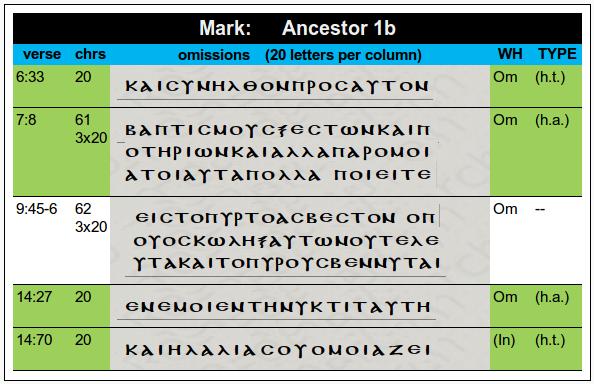
Candidates for Ancestor 2 are more certain, and hence more attractive, by the nature of the numbers, which offer less alternative line-lengths to choose from.
The Green color-coding here indicates more confidence both in the identification as homoeoteleuton, and the proposed line-length in the master-copy. Although the list is shorter, the existance of the exemplar is more certain:
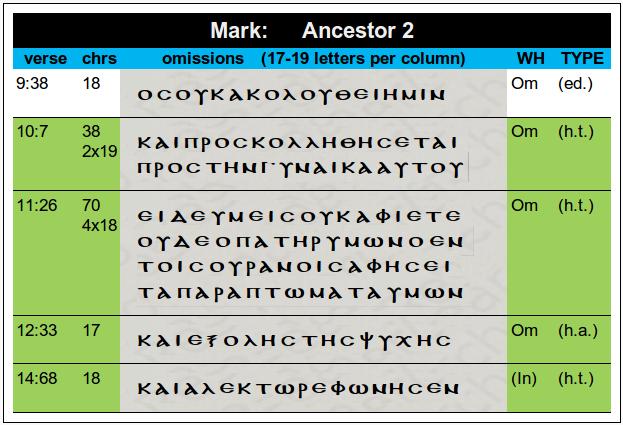
In the following list, some may actually belong to an ancestor with a different line-width, since the text can be divided up several ways. Note that the five single lines of 15 chars per line.
For reasons that are apparent, we call this group of omissions "Ancestor 3". This long list of 31 lines is a strong indication of line-width, since almost half of these Variation Units can be identified as homoeoteleuton, regardless of what width we select from the likely options. These omissions were certainly accidental, and so were caused by layout, not content. The lack of theological, historical, or linguistic reasons for the omissions/additions also corroborates an accidental cause.
This column width is relatively narrow, and so these omissions arose later in the copy-stream, when narrower columns were selected for the very purpose of cutting down on accidental copy-errors, i.e, 3rd century. It reflects the style of Codex Sinaiticus in terms of page format.
Earlier MSS had wider columns, before it was realised that errors could be minimised by better choices of format. Other groups of equal-length omissions are also found among the Aleph/B readings.
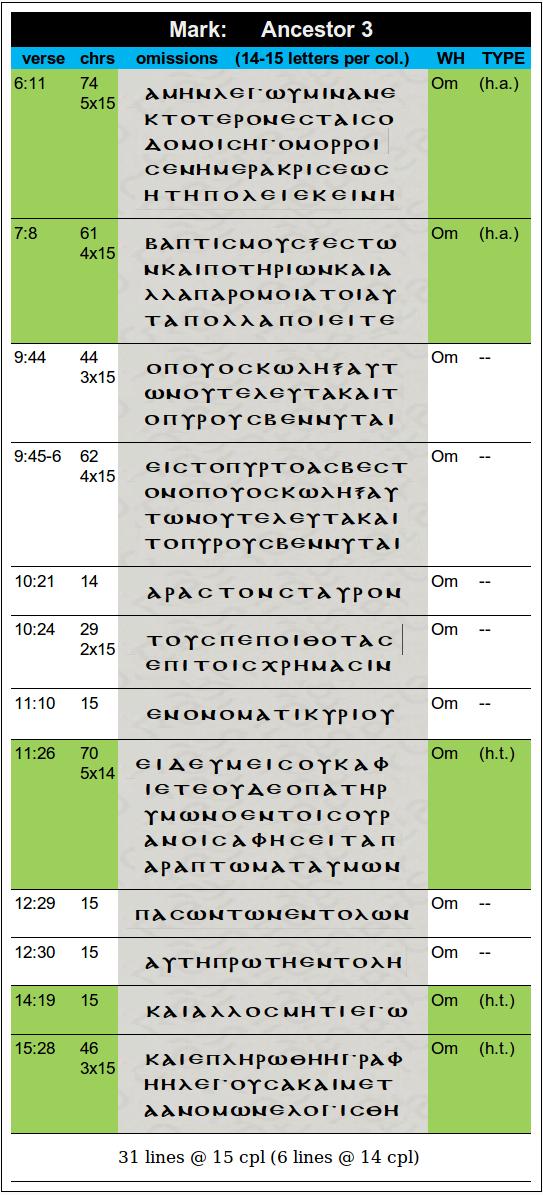
As the line-length decreases, the alternative options also decrease, making the identification of column-width more certain. One or two of these omissions could have been generated in an older, wider-column exemplar, much earlier in the transmission-stream, but more manuscripts would have been manufactured in the narrower format, as copying spread rapidly in the later centuries. The high line-count here (13 lines) lends probability to an exemplar of this width.

With Ancestor 5, we again have an encouraging number of lines of exact lengths. With cases of 10 and 20 letters per line, other column widths are unlikely and a poor fit, which increases the confidence level in the choice of 10 or 20.
With up to 19 different lines of about 10 characters, this seems like a solid choice for an exemplar somewhere in the copying generations, that would have caused these accidental omissions. Alternately, 20-21 cpl is an option for many readings, but would also suggest a different vulnerable ancestor, such as Ancestor 1a (or 1b).
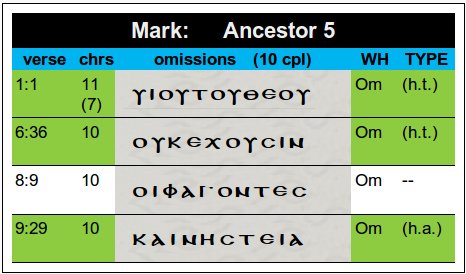
Manuscripts with columns narrower than 10 letters would be very rare, if they existed at all. Ancestor 6, then, really represents the 'left-overs'. Smaller omissions that are more likely to have been generated along the same line, or in the process of memorizing a long clause. They could have taken place at any time or generation of copy, and must be left as 'floating omissions'.
These proposed "Ancestors" must not be taken to imply that Aleph/B (the common ancestor of the two 4th century Uncials) is only a '7th generation copy' of the original Mark. This is far from likely.
It should be remembered that good copyists and their generations will be almost undetectable, since they will have reproduced their master-copy accurately. Only "bad" copies will be identifiable in a sorting process like the above.

What this evidence shows, in comparison with what we found regarding Matthew, is that Mark has suffered at least "7 bad generations" of copying, whereas Matthew has only seemed to have suffered about 3 or 4.
This is precisely what we should expect, since Mark is a much older document, and would have been subjected to more generations of corruption than Matthew. What we see then, is two different lines of bad copying converging in the 'ancestor' of Aleph/B. Originally, these gospels would have been copied as separate books, but were then brought together in the 2nd century.
The Omissions have been examined elsewhere (see our Homoioteleuton Blogsite for reconstructed layouts and textual evidences for these Variation Units.).
Our concern at the moment here is to show that:
a) Hort was wrong about the 'purity' of Aleph/B.
b) The textual history of the Aleph/B line of transmission can be reconstructed very adequately, with a proper consideration of all the available evidence and appropriate technique.
c) The Omissions of Aleph/B should never be adopted into the Christian NT text, except in certain extremely unusual circumstances.
This is an isolated, unreliable and infrequently corrected line of transmission, and all but useless for textual correction.
mr.scrivener
|
Ancestor 1: |
This copy is about 20-23 chars per line, and was probably a very good copy of Mark, containing most of the lines omitted by Aleph/B's ancestor. |
|
| At some point, a copyist used Ancestor 1 as a master-copy, but lost Mark 3:15, 6:33, 8:26, 14:27, 14:70, 15:3, 15:28, and probably Mark 7:8, 9:45. A copy of this became... |
|
Ancestor 2: |
At least one copy of this text was made 17-19 chars per line. But, it was not well corrected. |
|
|
A copy of Ancestor 2 was used as a master, but this bad copy lost text again: Mark 9:38, 10:7, 11:26, 12:33, 14:68 suffered eye-skips, which again escaped proof-readers. |
|
Ancestor 3: |
As errors accumulate in this isolated line, a 15-16 char per line copy is made. This width was meant to minimise copy errors. |
|
|
Somehow the new format adds yet more errors; Possibly overconfidence led to less checking. Mark 6:11, 9:44, 10:21, 10:24, 11:10, 12:29, 12:30, 14:19, and possibly Mark 9:45, 11:26, 5:28 were lost here. |
|
Ancestor 4: |
A new even narrower format is chosen, in the style of Codex Sinaiticus. The accumulated errors listed are not caught in the early stream. |
|
|
More errors accumulate; More unorganized practice? Mark 1:14, 1:42, 3:5, 7:16, 9:49, 11:8, 12:23, 13:11, 13:14 are the latest victims. |
|
Ancestor 5: |
Another narrower format is used. Accumulated errors listed go unnoticed. The Four Gospels may have been combined into a single MS at this point. |
|
|
Another generation results in more loss: Mark 1:1, 3:15, 6:33, 6:36, 8:9, 8:26, 9:29, 14:27, 14:70, 15:3 and possibly Mark 10:24 vanish. |
|
Proto-Aleph/B: |
This master-copy is the nearest ancestor of Aleph and B, and probably resided in the scriptorium at Caesarea where they were made. Short skips at Mark 7:2 and 11:23 are also lost at some unknown point. |
|
|
One or two shared readings might be coincidences, but most of those listed will come from the immediate ancestor of Aleph/B. |
|
א B |
The dying and deficient Alexandrian line. Erroneously approved by ecclesiastics, it was used briefly in Caesarea, but shortly thereafter abandoned for better copies. |

This page powered by:
RefTagger